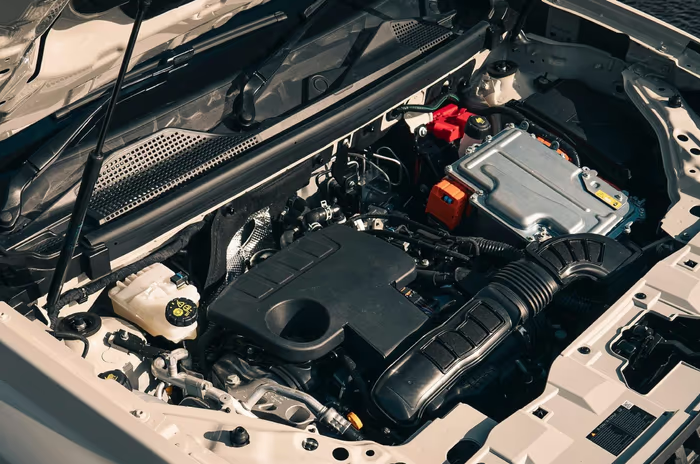Launched in 2021, the Harsh was Skoda’s first serious contender in the competitive C-SUV space. It gained popularity for its looks and driving dynamics, inspired by its well-sorted elder siblings. Four years down the line, it has received a younger sibling of its own – the Kylaq. Entering the lucrative sub-4 metre SUV space, the Kylaq is aimed at a younger audience while offering the same positives as the Kushaq. But how do these two fare against each other on paper, and which one is made for whom? Let’s break them down across key aspects—dimensions, features, powertrain, pricing, and who they’re really meant for.
Also Read: 2025 Skoda Kodiaq Review: There’s Still A Lot To Love!
Dimensions

In terms of dimensions, the Kushaq measures 4,225 mm in length, 1,760 mm in width, and stands 1,612 mm tall with a wheelbase of 2,651 mm and a ground clearance of 188mm. The boot space is a decent large at 385 litres. The newer Kylaq, on the other hand, is a sub-4 metre SUV, measuring 3,995 mm in length, 1,783 mm in width, and 1,619 mm in height.

Despite being smaller, it surprises with a boot space of 446 litres, thanks to clever packaging and slightly taller proportions. Its 2,566 mm wheelbase is shorter than the Kushaq’s, but the ground clearance is marginally better at 189mm.
Also Read: Skoda Kodiaq: Old vs New – What Has Changed?
Features

When launched, the Kushaq was Skoda’s take on the Creta-dominated segment. So, it came with all the features and equipment one could expect in the space, like the top-spec variant comes fitted with a 10-inch infotainment touchscreen, sunroof, wireless Android Auto/Apple CarPlay, ventilated front seats, six airbags, and a premium audio system. The fit and finish inside feel a bit more upmarket, too.

Similar to the elder sibling, the Kylaq too enters in a very toughly fought segment. In terms of equipment, it offers an 8-inch digital instrument cluster, 10.1-inch infotainment screen, ventilated seats, powered passenger front seats (segment-first), wireless smartphone connectivity, a single-pane sunroof, and six airbags—matching or even exceeding some of Kushaq’s mid-variants. In terms of safety, the Kushaq has scored 5 Stars in GNCAP, and Kylaq has done the same in BNCAP
Powertrain

Both these Czech SUVS share the same 1.0-litre TSI turbo-petrol engine, which produces 113 bhp and 178 Nm paired either with a 6-speed manual or a 6-speed torque converter automatic. But here’s where the Kushaq pulls rank over its younger sibling. It also offers a more powerful 1.5-litre TSI engine that generates close to 150bhp and 250 Nm, which can be had either with a 6-speed manual or a 7-speed DSG automatic. Neither of the two is available with a diesel, though, which is a choice that is available elsewhere in the segment.

Also Read: Skoda Kodiaq Laurin & Klement vs Sportline: Differences Explained
Price
Being smaller and more accessible to the masses, the Kylaq is clearly positioned as a more budget-friendly offering with prices starting at Rs 7.89 lakh and going up to Rs 14.40 lakh (ex-showroom). It makes for a great buy for first-time buyers who want the Skoda’s badge value, a compact yet sporty SUV that is also fun to drive, all under a tight budget of Rs 15 lakh. Meanwhile, the Kushaq starts at Rs 10.49 lakh and goes all the way to Rs 17.59 lakh for the top-end 1.5 TSI automatic. For the price premium, it gets you additional performance, more space inside the cabin, and a slightly better value proposition.
Which One Should You Buy?
Buy the Skoda Kylaq if:
– You want a well-built, European SUV with peppy driving dynamics on a budget.
– City manoeuvrability and compact dimensions are top priorities.
– You’re a first-time buyer looking for brand credibility.
Buy the Skoda Kushaq if:
– You need more space inside the cabin for family use.
– You want performance and refinement of the larger 1.5-litre TSI Evo engine.
– You’re looking for a more upmarket experience with long-term usage in mind.
Skoda has smartly positioned the Kylaq to attract a broader audience without diluting the brand’s identity. It undercuts most rivals with its features and design while still offering the European driving feel Skoda is known for. But the Kushaq remains a proper C-SUV if your budget allows it—it’s bigger, better to drive (in 1.5 TSI guise), and offers that extra polish. Both cars serve their purpose well. It’s simply a matter of deciding what you need most out of your Skoda.























































